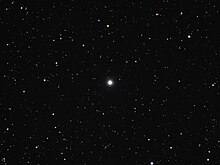| Observation data Epoch J2000.0 Equinox J2000.0 | |
|---|---|
| Constellation | Andromeda |
| Right ascension | 01h 39m 20.98857s[1] |
| Declination | +44° 23′ 10.2299″[1] |
| Apparent magnitude (V) | +5.01[2] |
| Characteristics | |
| Spectral type | G8 III[2] |
| U−B color index | +0.55[3] |
| B−V color index | +0.883[4] |
| Astrometry | |
| Radial velocity (Rv) | +6.54[5] km/s |
| Proper motion (μ) | RA: −13.395(126)[1] mas/yr Dec.: 8.635(85)[1] mas/yr |
| Parallax (π) | 12.3592 ± 0.1046 mas[1] |
| Distance | 264 ± 2 ly (80.9 ± 0.7 pc) |
| Absolute magnitude (MV) | +0.59[2] |
| Orbit[6] | |
| Period (P) | 20.8 ± 0.1 yr |
| Eccentricity (e) | 0.368 ± 0.020 |
| Periastron epoch (T) | 43,216 ± 60 MJD |
| Argument of periastron (ω) (secondary) | 144 ± 3° |
| Semi-amplitude (K1) (primary) | 3.01 ± 0.09 km/s |
| Details | |
| Radius | 9[5] R☉ |
| Luminosity | 47[5] L☉ |
| Surface gravity (log g) | 2.9[5] cgs |
| Temperature | 5,070[5] K |
| Metallicity [Fe/H] | –0.21[5] dex |
| Rotational velocity (v sin i) | 0.0[5] km/s |
| Other designations | |
| Database references | |
| SIMBAD | data |

Chi Andromedae (χ Andromedae, χ And) is the Bayer designation for a star in the northern constellation of Andromeda. It has an apparent visual magnitude of +5.01,[2] which is relatively faint for a naked-eye star. Based upon parallax measurements made during the Gaia mission, Chi Andromedae is located around 264 light-years (81 parsecs) from Earth.[1]
χ Andromedae is a member of 天大將軍 (Tiān Dà Jiāng Jūn), meaning Heaven's Great General, together with γ Andromedae, φ Persei, 51 Andromedae, 49 Andromedae, θ Andromedae, τ Andromedae, 56 Andromedae, β Trianguli, γ Trianguli and δ Trianguli. Consequently, the Chinese name for χ Andromedae itself is 天大將軍五 (Tiān Dà Jiāng Jūn wǔ, English: the Fifth Star of Heaven's Great General.)[8]
This is most likely a spectroscopic binary system with an estimated orbital period of 20.8 years and an eccentricity of 0.37. The primary component has a stellar classification of G8 III,[6] which indicates it is a giant star that has exhausted the supply of hydrogen at its core and evolved away from the main sequence. The outer envelope has expanded to about nine times the radius of the Sun and it is radiating 47[5] times the luminosity of the Sun at an effective temperature of 5,070 K.[5] This heat gives the star the yellow-hued glow of a G-type star.[9] It appears to be rotating very slowly with no measurable projected rotational velocity.[5] The secondary component seems to be a main-sequence star of the spectral class G or K.[6]
- ^ a b c d e f Cite error: The named reference
Gaia EDR3was invoked but never defined (see the help page). - ^ a b c d Cite error: The named reference
Anderson2012was invoked but never defined (see the help page). - ^ Cite error: The named reference
mnras133_475was invoked but never defined (see the help page). - ^ Cite error: The named reference
aaa474_2_653was invoked but never defined (see the help page). - ^ a b c d e f g h i j Cite error: The named reference
aj135_1_209was invoked but never defined (see the help page). - ^ a b c Cite error: The named reference
obs118_158was invoked but never defined (see the help page). - ^ Cite error: The named reference
SIMBADwas invoked but never defined (see the help page). - ^ (in Chinese) AEEA (Activities of Exhibition and Education in Astronomy) 天文教育資訊網 2006 年 7 月 10 日
- ^ Cite error: The named reference
csirowas invoked but never defined (see the help page).
